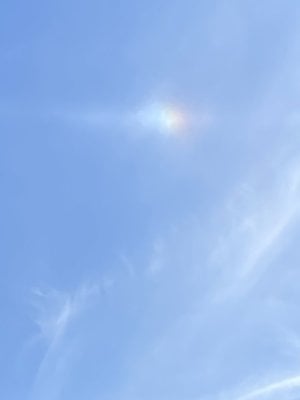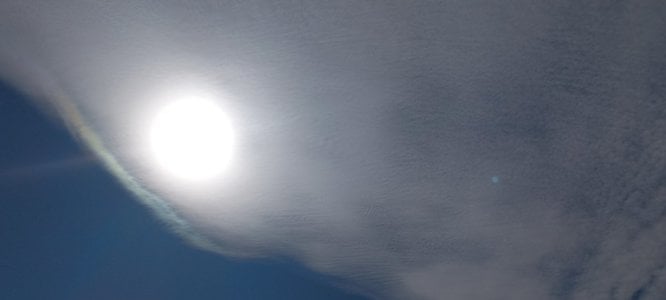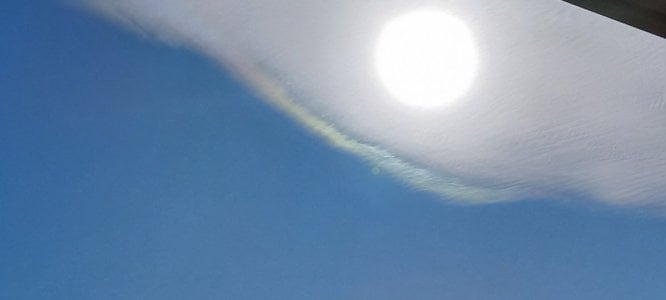Last edited by a moderator:
You are using an out of date browser. It may not display this or other websites correctly.
You should upgrade or use an alternative browser.
You should upgrade or use an alternative browser.
SDC Rewards Member
Upgrade yours now
This photo shows a rare phenomenon, a rainbow fragment. Well done on capturing a photo of it. Thank you for sharing it. See information below from www.thoughtco.com.
Iridescent Clouds: If you've ever spotted clouds high up in the sky with colours reminiscent of the film on a soap bubble or of oil film on puddles, then you've most likely seen the fairly rare iridescent cloud. Don't let the name fool you... an iridescent cloud isn't a cloud at all; it's simply the occurrence of colours in clouds. (In other words, any cloud type can have iridescence.) Iridescence tends to form high up in the sky near clouds, like cirrus or lenticular, that are made up of especially tiny ice crystals or water droplets. The tiny ice and water droplet sizes cause sunlight to be diffracted—it is obstructed by the droplets, is bent, and spreads out into its spectral colours. And so, you get a rainbow-like effect in the clouds. The colours in an iridescent cloud tend to be pastel, so you'll see pink, mint, and lavender rather than red, green, and indigo.
Sun dogs: Sun dogs offer another opportunity to see fragments of rainbow in the sky. Like iridescent clouds, they too form whenever sunlight interacts with ice crystals—except the crystals must be larger and plate-shaped. As sunlight hits the ice crystal plates, it is refracted—it passes through the crystals, is bent, and spreads out into its spectral colours. Since the sunlight is refracted horizontally, the sun dog always appears directly to the left or right side of the Sun. This often occurs in pairs, with one on each side of the Sun. Because sun dog formation depends on the presence of large ice crystals in the air, you'll most likely spot them in very cold winter weather; although, they can form in any season if high and cold cirrus or cirrostratus ice-containing clouds exist.
Iridescent Clouds: If you've ever spotted clouds high up in the sky with colours reminiscent of the film on a soap bubble or of oil film on puddles, then you've most likely seen the fairly rare iridescent cloud. Don't let the name fool you... an iridescent cloud isn't a cloud at all; it's simply the occurrence of colours in clouds. (In other words, any cloud type can have iridescence.) Iridescence tends to form high up in the sky near clouds, like cirrus or lenticular, that are made up of especially tiny ice crystals or water droplets. The tiny ice and water droplet sizes cause sunlight to be diffracted—it is obstructed by the droplets, is bent, and spreads out into its spectral colours. And so, you get a rainbow-like effect in the clouds. The colours in an iridescent cloud tend to be pastel, so you'll see pink, mint, and lavender rather than red, green, and indigo.
Sun dogs: Sun dogs offer another opportunity to see fragments of rainbow in the sky. Like iridescent clouds, they too form whenever sunlight interacts with ice crystals—except the crystals must be larger and plate-shaped. As sunlight hits the ice crystal plates, it is refracted—it passes through the crystals, is bent, and spreads out into its spectral colours. Since the sunlight is refracted horizontally, the sun dog always appears directly to the left or right side of the Sun. This often occurs in pairs, with one on each side of the Sun. Because sun dog formation depends on the presence of large ice crystals in the air, you'll most likely spot them in very cold winter weather; although, they can form in any season if high and cold cirrus or cirrostratus ice-containing clouds exist.
SDC Rewards Member
Upgrade yours now
Oh my goodness! I can't believe you captured a rare phenomenonUnusual Rainbow
Saw this unusual rainbow in the sky a few weeks ago, there had been no rain for it to appear. Is this a phonomon? It was a feast day of a saint in the Catholic faith.
I really did and took it on my phone. Earlier that day I saw the same thing over my grandsons school.Oh my goodness! I can't believe you captured a rare phenomenon
YA LEARN SOMETHING NEW EVERYDAY ! THANK YOU JAN A.This photo shows a rare phenomenon, a rainbow fragment. Well done on capturing a photo of it. Thank you for sharing it. See information below from www.thoughtco.com.
Iridescent Clouds: If you've ever spotted clouds high up in the sky with colours reminiscent of the film on a soap bubble or of oil film on puddles, then you've most likely seen the fairly rare iridescent cloud. Don't let the name fool you... an iridescent cloud isn't a cloud at all; it's simply the occurrence of colours in clouds. (In other words, any cloud type can have iridescence.) Iridescence tends to form high up in the sky near clouds, like cirrus or lenticular, that are made up of especially tiny ice crystals or water droplets. The tiny ice and water droplet sizes cause sunlight to be diffracted—it is obstructed by the droplets, is bent, and spreads out into its spectral colours. And so, you get a rainbow-like effect in the clouds. The colours in an iridescent cloud tend to be pastel, so you'll see pink, mint, and lavender rather than red, green, and indigo.
Sun dogs: Sun dogs offer another opportunity to see fragments of rainbow in the sky. Like iridescent clouds, they too form whenever sunlight interacts with ice crystals—except the crystals must be larger and plate-shaped. As sunlight hits the ice crystal plates, it is refracted—it passes through the crystals, is bent, and spreads out into its spectral colours. Since the sunlight is refracted horizontally, the sun dog always appears directly to the left or right side of the Sun. This often occurs in pairs, with one on each side of the Sun. Because sun dog formation depends on the presence of large ice crystals in the air, you'll most likely spot them in very cold winter weather; although, they can form in any season if high and cold cirrus or cirrostratus ice-containing clouds exist.
Last edited by a moderator:
SDC Rewards Member
Upgrade yours now
Wow, it looks like a blanket's being pulled over the sky!Hi. I also captured a similar thing here is SA mid July. Interesting to learn it was most likely an 'iridescent cloud'. I thought it looked like an oil slick perhaps from a plane that had passed over.
Join the conversation
News, deals, games, and bargains for Aussies over 60. From everyday expenses like groceries and eating out, to electronics, fashion and travel, the club is all about helping you make your money go further.
Seniors Discount Club
The SDC searches for the best deals, discounts, and bargains for Aussies over 60. From everyday expenses like groceries and eating out, to electronics, fashion and travel, the club is all about helping you make your money go further.
Latest Articles
-
‘Too easy’ to lose your licence—ex-police officer slams demerit point system

- Started by Maan
- Replies: 0
-
Ready to snap up some prizes before the year ends? You could take home up to $800K in Deaf Lottery’s latest raffle!

- Started by Danielle F.
- Replies: 0
-
You’ve been listening to him for years—now the man behind Hot Tomato has passed away

- Started by Maan
- Replies: 0
-
-





